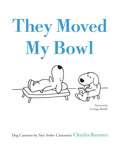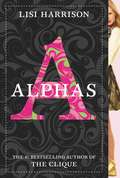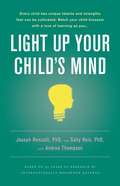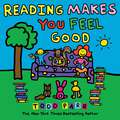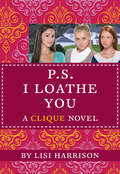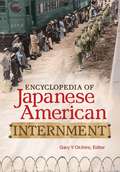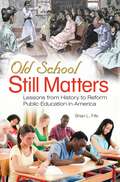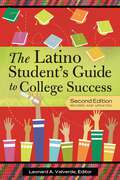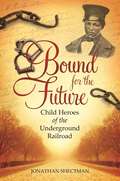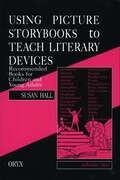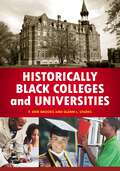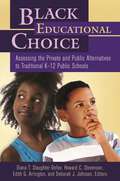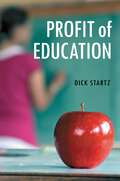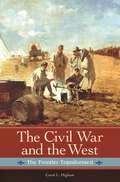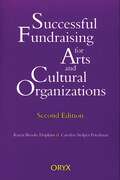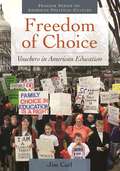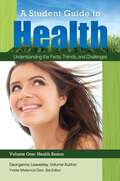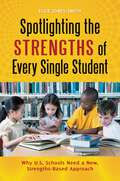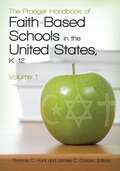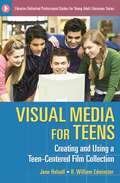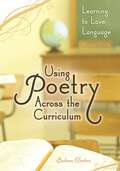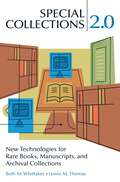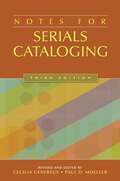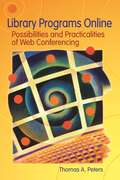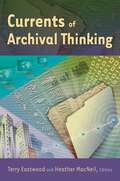- Table View
- List View
They Moved My Bowl: Dog Cartoons by New Yorker Cartoonist Charles Barsotti
by Charles BarsottiThis is the first, and long-overdue, book of CharlesBarsotti's dog cartoons. Barsotti's distinctive round pups,rendered in just a few simple lines, have been delighting TheNew Yorker readers for three decades and are instantlyrecognizable for their depiction of canines in human roles.The juxtaposition of their simple world, consistingonly of food, play, and the goings-on of their owners, withthe utterly human tasks of going to therapy, talkingbusiness, or seeing a lawyer, is both adorable and hilarious.A dog standing at a podium announces, "If elected, Ipromise to beg, fetch, and roll over." An older dog frownsdown at a young pup and says, "Don't be smug, all puppiesare cute." An angry dog with brush in hand paints a"BEWARE OF DOG" sign. With an irresistible blend ofbiting humor and affectionate observation, this is a perfectgift book for dog lovers everywhere.
Alphas #1 (The Clique #1)
by Lisi HarrisonAt OCD the losers are tormented.At Alpha Academy, they're sent home.Skye Hamilton has scored an invitation to the ultra-exclusive Alphas-only boarding school where beta is spelled LBR . What happens when the country's best, brightest, and hawtest begin clawing and scratching their way to the top?
Light Up Your Child's Mind: Finding a Unique Pathway to Happiness and Success
by Joseph S. Renzulli Sally M. ReisBased on the renowned Renzulli Method, which has been adopted in schools all over the country, Light Up Your Child's Mind presents a practical program to help children fire up a love of learning to last a lifetime. World-renowned experts Drs. Renzulli and Reis illustrate the crucial role parents can play in their children's development and address how they can work with teachers to enhance their children's education. They uncover the hidden potential of daydreamers, rebels, and one-track minds, arguing that gifted behavior -- basic smarts, high levels of task commitment, and creativity -- can be fostered in bright children, even unmotivated ones. Step by step, Light Up Your Child's Mind will show parents how to set their kids on the path to a rewarding future.
Reading Makes You Feel Good
by Todd ParrReading makes you feel good because...You can imagine you are a scary dinosaur,You can make someone feel better when they are sick,And you can do it anywhere!Reading Makes You Feel Good will inspire and encourage young children to delight in the joyful, rewarding experience of reading. With Todd Parr's trademark bright, bold pictures and silly scenes, kids will learn that reading isn't something that just happens at school or at home-it can happen anywhere! Todd shows us all the fun ways we can read- from in the library and in bed to in the bathtub and on the road. Targeted to those first beginning to read, this book invites children to read the main text as well as all the funny signs, labels, and messages hidden in the pictures.
P.S. I Loathe You (The Clique #10)
by Lisi HarrisonMassie Block: When the Pretty Committee deems its boy-fast null and void, boy fever sweeps through BOCD. What better way to backhandspring into new crush Dempsey's heart-and make old crush Derrington jealous-than cheer for him on the soccer field? And just like that, Massie forms BOCD's first-ever cheerleading squad. But will Massie still have something to cheer about when Dempsey starts spending ah lot of time with LBR Layne Abeley? Give me an "E" for Ehmagawd!Kristen Gregory: With Massie and her SBFF (secret best friend forever) Layne vying for the same boy, Kristen has to make a choice: A) the Pretty Committee, or B) the Witty Committee. And if she doesn't choose fast, she'll end up C) Committeeless.Dylan Marvil: Is hiding something, and it's not just those peanut butter Luna bars stashed under her mattress. She's got a secret crush on Derrington-and it's no secret that he likes burpilicious redheads. . . .Alicia Rivera: Prefers pliés to pom-poms, especially when Massie orders her to the bottom of the cheer-pyramid. Can Alicia accept her beta status, or is it time to become alpha of her own squad?Claire Lyons: Now that she's back with Cam, Claire finally has her love life in order. But her friends are trading crushes like styling tips. Will the Pretty Committee survive the boy-swap intact, or is the Clique about to come apart at the seams?
Encyclopedia of Japanese American Internment
by Gary Y. OkihiroThis book addresses the forced removal and confinement of Japanese Americans during World War II—a topic significant to all Americans, regardless of race or color.The internment of Japanese Americans was a violation of the Constitution and its guarantee of equal protection under the law—yet it was authorized by a presidential order, given substance by an act of Congress, and affirmed by the U.S. Supreme Court. Japanese internment is a topic that we as Americans cannot afford to forget or be ignorant of. This work spotlights an important subject that is often only described in a cursory fashion in general textbooks. It provides a comprehensive, accessible treatment of the events of Japanese American internment that includes topical, event, and biographical entries; a chronology and comprehensive bibliography; and primary documents that help bring the event to life for readers and promote inquiry and critical thinking.
Old School Still Matters: Lessons from History to Reform Public Education in America
by Brian L. FifeCan public schools in America be saved? This book considers theory, current practice, and the common school ideal through a historical lens to arrive at practical suggestions for reforming contemporary public education.Despite dramatic, sweeping changes in recent decades, a strong case can be made for guiding the reformation of contemporary public education in the United States on common school ideology of the nineteenth century. The author argues that the common school remains a public institution capable of preparing America's youth to contribute to the community in a positive manner, and that education must be treated at a public good where all children—regardless of social class—have a right to a quality education. The work includes a thorough overview of Horace Mann's writings on K–12 public education that support the common school ideal—concepts that are over 150 years old, yet still highly relevant today.
The Latino Student's Guide to College Success
by Leonard A. ValverdeThis book provides Latino students with a step-by-step roadmap for navigating the college process—from overcoming cultural barriers to attending college, to selecting the right school, to considering advanced degrees.The Latino community is the fastest growing minority group in America, and quickly becoming a major player in America's workforce. Unfortunately, Latinos encounter cultural and societal obstacles that can hinder academic achievement. This inspirational guide gives Latino students practical skills for advancing in a college environment.The Latino Student's Guide to College Success: Second Edition, Revised and Updated provides a blueprint for collegiate success. The first eight chapters guide students through subjects such as selecting a college, navigating the application process, forming effective study habits, accessing student support services, and planning for advanced degrees. The second part is comprised of eight inspirational stories by Latino graduates sharing their college experiences. Lastly, a third section features a listing of colleges with a record of graduating the most Latinos, as well as a list of the top ten colleges with the most undergraduate Latino students. The revised and updated second edition of this popular book features the latest economic and demographic changes that have emerged since the first edition was published. It also includes six new chapters introducing the impact of technological advancements and changes in cultural trends.
Bound for the Future: Child Heroes of the Underground Railroad
by Jonathan ShectmanThrough careful, detailed consideration of a host of primary documents about the young activists who formed the Underground Railroad's underappreciated operational workforce, this book offers fresh insight to the complex question, "Who ended slavery?"Bound for the Future: Child Heroes of the Underground Railroad illuminates the vital contributions of specific, underappreciated child activists within the extremely local circumstances of their daily work. It also provides meaningful context to the actions of these young activists within the much broader social practice of resisting slavery, and offers fresh insight into the complicated question of who was responsible for ending slavery. Through a thorough examination of these subjects, author Jonathan Shectman proves his central thesis: in many specific cases, children were the essential lifeblood of the Underground Railroad's operational workforce. This text will appeal to wide range of readers, including young students, educators, scholars, and anyone seeking a fresh perspective on civil rights, anti-slavery activism, and U.S. history.
Using Picture Storybooks to Teach Literary Devices: Recommended Books for Children and Young Adults (Using Picture Books to Teach)
by Susan HallThe third volume of Using Picture Storybooks to Teach Literary Devices joins volumes 1 and 2 of this best-selling series to give teachers and librarians the perfect tool to teach literary devices to students in grades K-12. In this volume, 120 well-reviewed picture storybooks, published mainly in the last few years, are listed (sometimes more than once) under 41 literary devices. All-ages picture storybooks, which can be enjoyed by adults, as well as children, are included. For each device, a definition is given, and descriptions of appropriate storybooks, with information on how to use them, the art style used in the book, and a curriculum tie-in, are provided. Among the literary devices included are alliteration, analogy, flashback, irony, metaphor, paradox, tone, and 34 more. Indexes by author, title, art style, and curriculum tie-in add to this outstanding book's great value. Grades 4-12.
Historically Black Colleges and Universities: An Encyclopedia
by F. Erik Brooks Glenn L. StarksThis exhaustive analysis of Historically Black Colleges and Universities (HBCUs) throughout history discusses the institutions and the major events, individuals, and organizations that have contributed to their existence.The oldest HBCU, Cheyney University of Pennsylvania, was founded in 1837 by Quaker philanthropist Richard Humphreys as the Institute for Colored Youth. By 1902, at least 85 such schools had been established and, in subsequent years, the total grew to 105. Today approximately 16 percent of America's black college students are enrolled in HBCUs. Historically Black Colleges and Universities: An Encyclopedia brings the stories of these schools together in a comprehensive volume that explores the origin and history of each Historically Black College and University in the United States. Major founders and contributors to HBCUs, including whites, free blacks, churches, and states, are discussed and distinguished alumni are profiled. Specific examples of the impact of HBCUs and their alumni on American culture and the social and political history of the United States are also examined. In addition to looking at the HBCUs themselves, the book analyzes historical events and legislation of the past 174 years that impacted the founding, funding, and growth of these history-making schools.
Black Educational Choice: Assessing the Private and Public Alternatives to Traditional K–12 Public Schools
by Diana T. Slaughter-Kotzin Howard C. Stevenson Edith G. Arrington Deborah J. JohnsonThis important book provides African American parents with the knowledge to diversify K–12 school choices beyond traditional neighborhood public schools in order to optimize the educational chances of their own children, and it will help educators and policymakers to close the black-white academic achievement gap throughout America.Closing the K–12 achievement gap is critical to the future welfare of African American individuals, families, and communities—and to the future of our nation as a whole. The black-white academic achievement gap—the significant statistical difference in academic performance between African American students and their white peers—is the single greatest impediment to achieving racial equality and social justice in America.Black Educational Choice provides parents, citizens, educators, and policymakers the critical knowledge they need to leverage the national trend toward increasing and diversifying K–12 school choice beyond traditional neighborhood public schools. Parents can use this information to optimize the success of their own African American children, while policymakers and educators can apply these insights to help close the black-white academic achievement gap throughout America. The book collects the interdisciplinary, multi-racial, and multi-ethnic perspectives of education experts to address the questions of millions of anxious African American families: "Would sending our children to a private school or a charter school significantly better their chances of closing the achievement gap and becoming successful individuals? And if so, what kinds of challenges would they likely experience in these alternative educational settings?"
Profit of Education
by Richard StartzThis important book translates evidence and examines policy, proposing a plan to save America's schools by rewarding teachers with professional-level salaries distributed wisely.Profit of Education makes it clear that rethinking the teaching profession is the key to repairing America's broken-down education system and securing our nation's future. Accomplishing that, author Dick Startz says, requires lifting teacher pay to professional levels and rewarding teachers for student success, with the goal of improving student learning by the equivalent of one extra year of schooling.Profit of Education takes the reader on a chapter-by-chapter walk through the evidence on pay-oriented, teacher-centric reform of the public school system, showing that such an approach can work. Startz translates the extensive scientific evidence on school reform into easily understood terms, demonstrating the enormous difference teachers make in student outcomes. Proposed levels of teacher salaries are established, and the difficult issue of differential pay is examined in depth, as are many of the practical and political issues involved in measuring teacher success. Last, but hardly least, Startz shows how teacher-centric school reform will pay off for the taxpayer and the economy.
The Civil War and the West: The Frontier Transformed (Reflections on the Civil War Era)
by Carol L. HighamBetween 1800 and the Civil War, the American West evolved from a region to territories to states. This book depicts the development of the antebellum West from the perspective of a resident of the Western frontier.What happened in the West in the lead-up to and during the American Civil War? The Civil War and the West: The Frontier Transformed provides a clear and complete answer to this question. The work succinctly overviews the West during the antebellum period from 1800 to 1862, supplying thematic chapters that explain how key elements and characteristics of the West created conflict and division that differed from those in the East during the Civil War. It looks at how these issues influenced the military, settlement, and internal territorial conflicts about statehood in each region, and treats the Cherokee and other Indian nations as important actors in the development of a national narrative.
Successful Fundraising for Arts and Cultural Organizations: Second Edition
by Carolyn S. Friedman Karen B. HopkinsFundraising experts Karen Brooks Hopkins of the Brooklyn Academy of Music and Carolyn Stolper Friedman of the Contemporary Museum of Art in Chicago offer important insights into today's best fundraising strategies for arts and cultural organizations of all sizes. New to this edition is an in-depth examination of corporate sponsorships, as well as a detailed chapter on endowment campaigns. All statistics, appendixes, and examples have been updated, and many helpful examples, including pledge forms, campaign statements, and sponsorship contracts, are also included.
Freedom of Choice: Vouchers in American Education (Praeger Series on American Political Culture)
by Jim CarlThis book reveals that, far from being the result of a groundswell of support for parental choice in American education, the origins of school vouchers are seated in identity politics, religious schooling, and educational entrepreneurship.Inserting much-needed historical context into the voucher debates, Freedom of Choice: Vouchers in American Education treats school vouchers as a series of social movements set within the context of evolving American conservatism. The study ranges from the use of tuition grants in the 1950s and early 1960s in the interest of fostering segregation to the wider acceptance of vouchers in the 1990s as a means of counteracting real and perceived shortcomings of urban public schools. The rise of school vouchers, author Jim Carl suggests, is best explained as a mechanism championed by four distinct groups—white supremacists in the South, supporters of parochial school in the North, minority advocates of community schools in the nation's big cities, and political conservatives of both major parties. Though freedom was the rallying cry, this book shows that voucher supporters had more specific goals: continued racial segregation of public education, tax support for parochial schools, aid to urban community schools, and opening up the public school sector to educational entrepreneurs.
A Student Guide to Health [5 volumes]: Understanding the Facts, Trends, and Challenges [5 volumes]
This comprehensive, five-volume reference set is aligned with the National Health Education Standards, containing up-to-date, scientifically based information on a variety of health and wellness topics relevant to high school students.A Student Guide to Health: Understanding the Facts, Trends, and Challenges provides straightforward, factual, and accessible information about a multitude of health issues. It is an essential reference set that provides high school students, teachers, and administrators with a comprehensive health and wellness education resource that aligns with National Health Education Standards and common health curriculum. This expansive five-volume set is ideal for students' research projects; highly useful as a resource for community college and public library patrons, librarians, teens, and parents; and is a suitable supplement to any health education curriculum.Each chapter includes up-to-date, evidence-based information that provokes further examination and encourages critical thinking to evaluate the validity of information encountered about health and wellness topics. Each chapter provides an abundance of references and lists of resources for further information, including books, articles, websites, organizations, and hotlines. Special attention is paid to social trends that affect youth health and wellness, such as bullying, eating disorders, steroid abuse, sexting, and the peer pressure associated with drug use and abuse.
Spotlighting the Strengths of Every Single Student: Why U.S. Schools Need a New, Strengths-Based Approach
by Elsie Jones-SmithThis book explains how a teaching system focused on identifying and stoking each student's strengths—rather than concentrating on deficits—can bring remarkable academic improvement and achievement.It's a familiar and seemingly logical model: to improve performance, identify weaknesses and target these problem areas. Could doing the opposite be a better way? Licensed clinical psychologist Elsie Jones-Smith argues that strengths-based systems are indeed more effective—not just in social work, where the philosophy became popular; or in the business world, where the concept is increasingly being embraced—but in the academic setting as well.Spotlighting the Strengths of Every Single Student: Why U.S. Schools Need a New, Strengths-Based Approach explains how and why a system that focuses on students' strengths enables kids to be self-confident, goal-directed, and to possess a stronger sense of self-efficacy, self-control, and academic achievement. Jones-Smith also explains how such a system spurs appreciation and advancement of multiple intelligences, which in turn gives students the ability to address weaknesses—on their own. Another plus: this approach has also been shown to generally reduce school disciplinary actions and increase class attendance time.
The Praeger Handbook of Faith-Based Schools in the United States, K–12 [2 volumes]: [2 volumes]
by Thomas C. Hunt James C. CarperExploring a subject that is as important as it is divisive, this two-volume work offers the first current, definitive work on the intricacies and issues relative to America's faith-based schools.The Praeger Handbook of Faith-Based Schools in the United States, K–12 is an indispensable study at a time when American education is increasingly considered through the lenses of race, ethnicity, gender, and social class. With contributions from an impressive array of experts, the two-volume work provides a historical overview of faith-based schooling in the United States, as well as a comprehensive treatment of each current faith-based school tradition in the nation. The first volume examines three types of faith-based schools—Protestant schools, Jewish schools, and Evangelical Protestant homeschooling. The second volume focuses on Catholic, Muslim, and Orthodox schools, and addresses critical issues common to faith-based schools, among them state and federal regulation and school choice, as well as ethnic, cultural, confessional, and practical factors. Perhaps most importantly for those concerned with the questions and controversies that abound in U.S. education, the handbook grapples with outcomes of faith-based schooling and with the choices parents face as they consider educational options for their children.
Visual Media for Teens: Creating and Using a Teen-Centered Film Collection (Libraries Unlimited Professional Guides for Young Adult Librarians Series)
by Jane Halsall R. William Edminster C. Allen NicholsDazzle teens with a film collection custom-designed to fit their interests and tastes! If you would like to build or develop a film collection with guaranteed teen appeal, this guide is for you. It discusses what's current, popular with teens, and available; and provides annotated core filmographies in categories of heroes, exploring issues of identity, strong emotions: horror and humor, and educational entertainment. In addition, the authors address popular culture influences on teens, technology and format issues, how to get teen input, where to find reliable review sources, programming with films, and promoting and merchandising your collection. Packed with ideas as well as nitty gritty information; this guide fills a gap in the literature and a real need for the profession.Dazzle teens with a film collection custom-designed to fit their interests and tastes! This guide is designed for those who would like to build or develop a film collection with guaranteed teen appeal. It discusses what's current, popular with teens, and available; and provides annotated core filmographies in categories of heroes, exploring issues of identity, strong emotions: horror and humor, and educational entertainment. In addition, the authors address popular culture influences on teens, technology and format issues, how to get teen input, where to find reliable review sources, programming with films, and promoting and merchandising your collection. Packed with ideas as well as nitty gritty information; this guide fills a gap in the literature and a real need for the profession.
Using Poetry Across the Curriculum: Learning to Love Language
by Barbara ChattonThis comprehensive listing and discussion of poetic works supports the standards of all areas of the curriculum, helping librarians and teachers working with kindergarten through middle school students.This second edition of Using Poetry Across the Curriculum: Learning to Love Language offers a comprehensive list of poetry anthologies, poetic picture books, and poetic prose works in a wide variety of subject areas. While it maintains the original edition's focus on ideas and resource lists for integration of poetry into all areas of the curriculum, it is thoroughly revised to cover current issues in education and the wealth of new poetry books available.The book is organized by subject areas commonly taught in elementary and middle schools, and, within these, by the national standards in each area. Numerous examples of poetry and poetic prose that can be used to help students understand and appreciate aspects of the standard are listed. A sampling of units that arise from groups of works, writing and performance ideas, and links across the curriculum is also included. While many teaching ideas and topics provide references to the standards they meet, this title is unique in starting with those standards and making links across them.
Special Collections 2.0: New Technologies for Rare Books, Manuscripts, and Archival Collections
by Beth M. Whittaker Lynne M. ThomasA critical examination of Web 2.0 tools used in special collections, archives, and museums, with an emphasis on using interactive technology to create and preserve content.Based on surveys and firsthand research across the archivist's profession, Special Collections 2.0: New Technologies for Rare Books, Manuscripts, and Archival Collections offers essential advice and practical ideas for creating, collecting, and preserving born-digital materials for optimal long-term access—using the best of what the new Web has to offer. Special Collections 2.0 surveys the web's new options for interconnectivity and interactivity tool by tool, exploring the benefits and shortcomings of applying each to the special collection and archives profession. It combines expert analysis of the pros and cons of Web 2.0 with numerous reports of how wikis, blogs, photosharing, social networks, and more are already being put to work in this essential field. Creators, researchers, and caretakers of the historic record—even those anxious about using the Internet—will understand the best ways to put Web 2.0 to work in the service of our cultural heritage.
Notes for Serials Cataloging
The last decade has brought a great deal of change to serials and to scholarly communication as a whole. Serials have gone online or online only with a rapidness few expected; and many libraries now spend half or more of their materials budgets on electronic journals. Arranged in MARC tag order and by topical subdivision, the latest edition of Notes for Serials Cataloging is designed to help both novice and experienced serials catalogers describe the complex characteristics and relationships of serial publications and construct clear and concise notes. In addition to updated definitions, scope notes, and examples of notes presented in previous editions, it incorporates notes used in electronic serials cataloging as well as covers changing practices in MARC note field usage in keeping with CONSER standards.
Library Programs Online: Possibilities and Practicalities of Web Conferencing
by Thomas A. PetersMeet your library patrons where they increasingly live and work-online. This guide introduces you to the exciting possibilities online programs offer, and shows you how to set up online programs in your library-whether one-time stand-alone or half-day, full-day, or multi-day workshops and conferences. Public programs-from lectures, demonstrations, and interviews to book discussions and story hours can be delivered in real time (live) primarily over the web, utilizing a variety of interactive communication tools, including voice-over-IP, text chatting, and co-browsing. Furthermore, online programming can be used for district-wide staff training. The author explains how to integrate pre-recorded components of a program into a live, online public program; shows how to extend the reach and appeal of online public programs with podcasting and audiorecordings; and explains how to use voice-over-IP and video-over-IP to enhance online programs. In addition to outlining the costs of staring and operating a public online program, Peters also provides cost recovery methods and scenarios. Online public programs can extend your library's reach into the service population, grab the attention of some early adopters and opinion leaders in the community you serve, and convey to patrons and other libraries that your library is moving boldly into the digital future. Plus, many people are more likely to attend an online library program than an in-library public program. And because online programs are easily recorded and redistributed on demand, your library gets more bang for each buck it invests in its public programming outreach.Distance education programs in higher education, corporate and governmental training efforts, and other sectors of society have become commonplace, but this is the first guide to focus on how libraries (public, academic, school, and special) and library-related organizations (associations, consortia, etc.) can and are developing exciting online programs for library users and librarians.
Currents of Archival Thinking
Currents of Archival Thinking explores key topics in the theory and practice of archival studies within three frameworks: (1) the foundational concepts of the discipline, (2) the main components of the archival mission, and (3) the metaphors that shape how we think about archives and archival institutions. Each essay will explore a given topic from both a historical and contemporary perspective, with contributors drawn from Europe, Australia, Canada, and the United States and featuring a mix of academics and practitioners.
